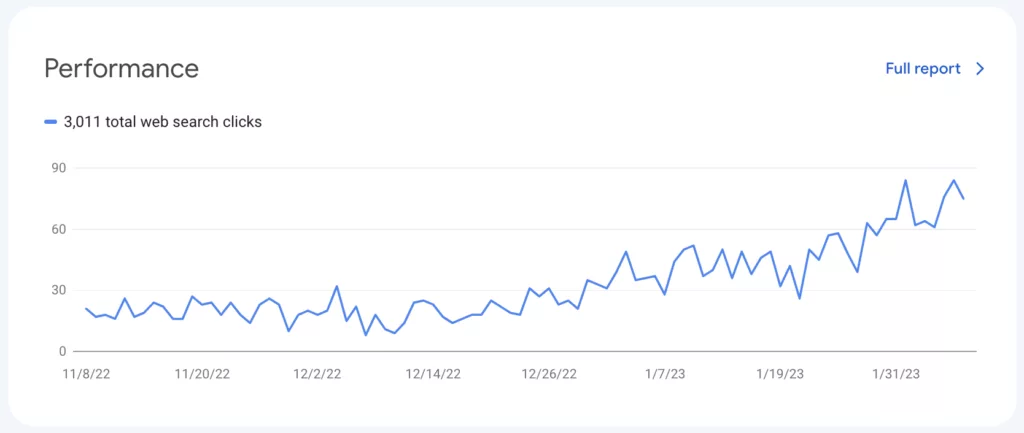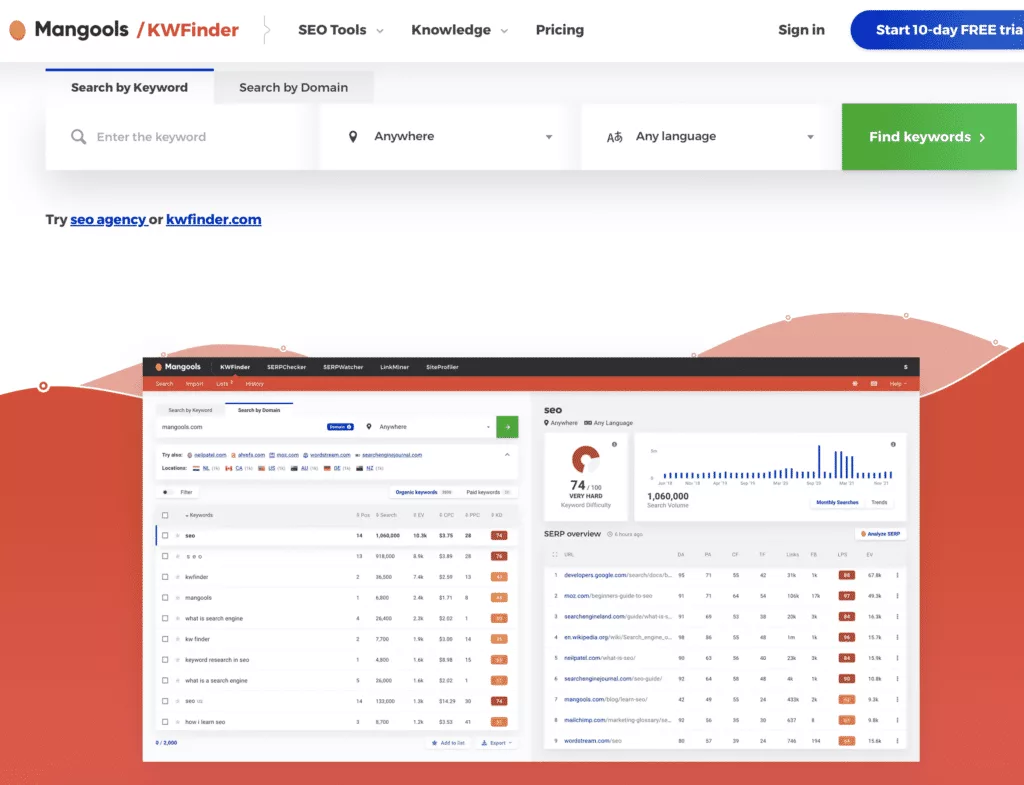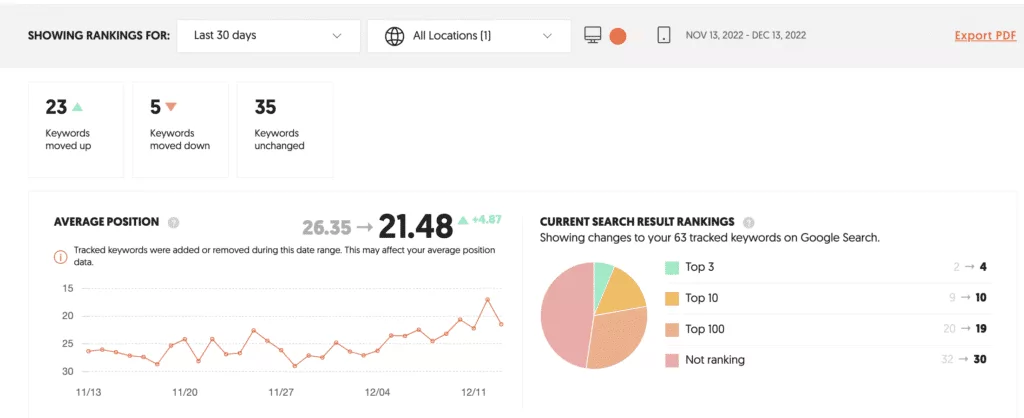With search engine optimization, a lot of people wonder if it still works nowadays. The answer to that is yes. But the strategies and tactics used by search engine optimization experts have evolved over time.
In this blog, we talk about search engine optimization, what it is, and why it’s important for your business. We also discuss the types of strategies that can be implemented to improve ranking on search engines.
How does search engine optimization work?
Crawlers, sometimes also called spiders or bots, are used to gather information about all the content found on the internet and index it for search engines.
They help search engines understand the web’s content better and can be very valuable in terms of increasing search results ranking.
Search engine algorithms use complex algorithms to pull out the most accurate, relevant, and useful results for queries. They work constantly to determine the best results for queries across a wide variety of factors such as keyword relevance, content quality, and organic rankings.
Search engine optimization is the process of improving a website’s visibility on search engines like Google by following best practices and strategies.
This involves implementing on-page optimization strategies, such as keyword research and on-page optimization, as well as off-page optimization strategies such as backlinks building and social media marketing.
Also known as search engine optimization (SEO), it is a process of creating high-quality content on a website that is relevant to queries to improve its ranking in search engine results in pages.
How is SEO different from SEM and PPC?
– SEO (Search engine optimization) is a marketing strategy that focuses on organic ranking algorithms to determine a website’s position on search engine results pages (SERPs).
– SEM (search engine marketing) and PPC (pay-per-click) are paid search methods.
– SEM is an umbrella term that is used to cover both of these activities.
– In organic rankings, search engines take into consideration factors such as content quality, user experience, and keyword optimization in determining a website’s ranking on search results pages.
– With search engine optimization, webmasters create high-quality content and optimize it to rank high on search engine results pages. This includes creating unique content and keyword research, as well as writing high-quality content and using relevant keywords in the meta tags of the website.
– The higher a website ranks on search results pages, the more traffic it receives from search engine queries.
– When compared to pay-per-click, organic ranking strategies are cheaper but take a longer time for results to appear on search engine results pages. Also, organic strategies are considered more credible than paid strategies by most web users.
SEO vs. SEM
Search engine optimization (SEO) is an organic ranking algorithm used to rank search results on search engine results pages (SERP). Ads, such as pay-per-click (PPC) ads, are distinct from organic search results in that they are positioned based on advertiser bids and not organic ranking algorithms. SEM is an acronym for search engine marketing and includes both SEO and PPC strategies. PPC ads are different from organic search results in that they are placed on search engine results pages based on bid costs rather than algorithm quality.
In other words, PPC ads are only relevant if a user is searching for specific keywords or phrases. organic content is determined by how relevant the user and their search query are to the content on a website. Quality of organic traffic depends on whether relevant content exists on a website, which can be measured by keyword relevance and a number of page views.
Why is SEO important?
- Search engine optimization (SEO) plays a key role in improving website rankings, driving more traffic to websites, and increasing brand awareness.
- With the right strategies and tactics, you can increase the visibility of your website on search engines and drive high-quality traffic to your website.
- This will help you increase organic search engine results ranking, which is vital for keyword ranking on the first three organic results of search engine results.
- In this regard, it’s essential to understand how search engines work, what factors affect ranking on them, and how to optimize content for organic search engine results.
- Also, it’s vital to implement practices that are beneficial for both organic search engine ranking and analytics.
Why SEO focuses on Google

Search engine optimization, or SEO, is a process that focuses on improving the visibility of your website in search engines like Google.
It focuses on factors like keyword optimization, social media optimization, and back-linking to improve search engine results page rankings. SEO focuses on optimizing content to make sure it is of the highest quality and relevance to rank as high as possible on search engine results pages.
This helps users find relevant results faster and easier. Besides, SEO is beneficial for both users and search engines as it helps users find the most relevant and useful content for their queries on search engines.
What Google wants
Search engine optimization (SEO) is an essential part of digital marketing that website owners need to focus on if they want to increase their visibility online. SEO involves strategies and processes that help websites naturally rank high on search engines like Google. In exchange for ranking high in search results, website owners must create quality content that is unique and relevant to a user’s query. Additionally, website owners must ensure that their content is technically optimized and user-friendly.
Google recommends that website owners use technical SEO strategies such as URL selection, technical optimization, and SEO marketing to improve their ranking on search results pages. Other factors to consider when optimizing a website for search results include keyword research and title optimization.
Website owners should also follow webmaster guidelines from search engines such as Google and Bing to ensure high-quality content is displayed in search results. Overall optimization of a website will help it rank high on search results page and attract more organic traffic from search queries.
Types of SEO
Search engine optimization (SEO) is the process of creating content on a website or digital asset that can be easily found and ranked high on search engines like Google, Bing, and Yahoo. It involves optimizing keyword-stuffed content on a website so it can rank high in search engine results.
In other words, it’s the practice of making a website visible and relevant on search engine rankings through high-quality content creation.
The three main types of SEO are on-page optimization, off-page optimization, and technical optimization.
On-page optimization involves optimizing the quality and structure of content on individual web pages. This includes keywords research, keyword optimization, keyword stuffing, meta tag optimization, page title tag research, page title tag optimization, headings research and analysis, page content research and analysis, keyword use in content research and analysis, keyword use in headings research and analysis, tag line research and analysis, keyword use in tag lines research and analysis.
Off-page optimization involves building backlinks to external websites from relevant authoritative websites on the same topic or using keyword-targeting engines to find high-quality backlinks from relevant websites to the one being optimized. It also involves building internal links between web pages on a website so that search engine spiders can easily navigate from one page to another.
Technical optimization involves improving a website’s performance on search engines through security practices such as HTTPS encryption for improved ranking on search engine ranking factors like Secure Content ranking factor (SC-ranking), user experience factor (UX-ranking), and organic search ranking factor (O-ranking). It also involves developing a user interface (UI) for optimized user experience on different devices such as desktops and laptops as well as mob
Technical Optimization
Search engine optimization (SEO) is the practice of optimization of a website to improve its visibility and ranking in search engine results. Technical SEO includes a variety of optimization techniques, including optimizing content, optimizing images, and creating internal links.
It also involves making sure the website is functioning properly, including improving page speed, fixing broken links, and ensuring mobile-friendliness. Technical SEO also includes optimizing the HTML code and page structure of the website to make it easier for search engine crawlers to index the website and its content.
All of these strategies work to ensure that search engines can easily find and index your website. In addition to technical optimization, user-friendly optimization strategies are essential for creating an effective website that users will find helpful and relevant.
Content optimization

SEO stands for search engine optimization and is a set of strategies that help websites to be more visible in search results. The goal of content optimization is to publish high-quality content on a website. High-quality content will include relevant, keyword-rich, and unique content that will help users find the information they are looking for on the website. When optimizing content on a website, it’s important to cover relevant topics, include keywords, and use multimedia to bring quality content to the page.
Content optimization helps search engines identify helpful content on a website and helps improve user experience on social media platforms such as Facebook and Twitter. SEO is a set of practices that help align webpage content with search engine ranking algorithm requirements.
Off-site optimization
Off-site optimization is a key factor in search engine optimization (SEO). It involves getting backlinks from external websites to help boost a website’s visibility in search engine results pages. off-site optimization can be achieved by submitting content to other websites, building relationships with influencers, and participating in online conversations.
It is essential to get links from high-quality, relevant websites to maximize the benefit of off-site optimization. It is also beneficial to optimize social media profiles to improve brand awareness and reach. By optimizing off-site strategies and engaging with social media, businesses can ensure visibility on search engine results pages and attract more organic traffic.
SEO specialties
Search engine optimization (SEO) is a process of improving search engine ranking results on search engines such as Google, Yahoo, and Bing by writing quality content and implementing social media strategies. SEO includes on-page optimization (writing high-quality content), off-page optimization (building quality links), and technical optimization (optimizing the website’s structure). Other types of SEO specialized include local SEO, international SEO, and mobile SEO.
How does SEO work?
- SEO is the process of optimizing the content on a website for search engine visibility. It involves creating content that is relevant and keyword-rich, implementing search engines optimization practices such as on-page and off-page optimization, and building backlinks to earn high rankings on search engines.
- In the age of digital marketing, search engine optimization (aka SEO) has gained prominence as an important factor in ranking websites on search engine results pages (SERPs). This practice aims to generate targeted traffic to a website through organic search engine rankings.
- To achieve high rankings via organic search, organizations must create quality content that is optimized for keyword picking. This entails writing content with relevant keyword usage and incorporating factors that can be used to improve search engine rankings, such as keyword density and keyword relevance.
- Another aspect of SEO is social media optimization. This involves creating content for social media platforms such as blogs and social media accounts, developing strategies on how to promote content on social media channels, and analyzing social media analytics data to identify trends and insights.
- With the help of bots, search engines can crawl through content on websites and build an index of the data. This ensures that all relevant information is available for ranking purposes. The quality of content on a website directly impacts its organic search ranking.
1. Understanding how search engines work
Search engines use spiders, also known as bots or spiders, to collect information about the content on the internet. When a user types a query into a search engine, search engine optimization software uses complex algorithms to generate search results. These results may include website content relevant to the query. Search engine optimization is the process by which marketers attempt to make their website more visible in search engine results pages. By optimizing their website content and keyword usage, marketers can increase their chances of appearing on search results pages.
Search engines survey the network of websites on the web and apply an algorithm to determine which results to display. The algorithm takes into account factors such as keyword relevance and user relevance in determining which results are displayed on search engine results pages (SERPs). Additionally, search engines may use keyword optimization techniques such as keyword research and keyword ranking strategies. These strategies help search engines identify relevant keywords for displaying on SERPs and improve search engine rankings.
2. Researching

SEO stands for search engine optimization and is the practice of creating and optimizing content to make it more visible to search engines. SEO focuses on the quality and relevance of content to help search engines determine what a page is about.
It involves keyword optimization, building backlinks, and building a presence on social media. All this work helps search engines find relevant content faster and more accurately. When a user types a query into the search box, search engines use algorithms to provide results that are relevant and accurate. Overall, SEO works by creating high-quality content that helps search engines find relevant results faster and more accurately.
3. Planning

Search engine optimization (SEO) is a process of improving the visibility of a website in search results on search engines like Google, Bing, and Yahoo. It involves taking steps to ensure that the website is high-quality, relevant, and consistent with search results.
To ensure high-quality content on your website and to optimize it for search engines, you must plan your content by understanding your audience’s wants and needs and by using data and strategies provided by Google. To stay up-to-date with current trends and topics, make sure that your content covers relevant topics.
Additionally, search engine optimization involves strategies such as creating high-quality content that search engines and your target audiences will love. This can be done by ensuring that the content is unique or original; well-written; free of grammatical and spelling errors; and includes multimedia such as images or videos.
4. Creating and implementing
Search engine optimization (SEO) work involves creating and optimizing content and code for both people and search engines. SEO involves developing helpful, high-quality content to meet the needs of an audience and ranking high in search results on organic search engines.
SEO tasks include creating content, optimizing content with keywords, and building backlinks to website pages. Another component of SEO is search intent, high-quality content, and emerging SEO trends. Creating high-quality content and engaging with search engines are all part of the optimization process.
5. Monitoring and maintaining
Regular monitoring of search engine optimization (SEO) can help ensure websites stay on top of search results. A good way to monitor your SEO performance is using web analytics. You can use web analytics to track user engagement on your website, as well as search engine ranking positions. It is important to regularly check search engine results pages (SERPs) for any changes in rankings. This will ensure that you are getting the best possible results from your SEO efforts. It is also a good idea to use tools that allow you to keep track of changes in SERP rankings and keyword optimization over time. Reviewing content optimization reports on a regular basis will further help you understand the results of your SEO efforts.
5. Monitoring and maintaining
Search engine optimization (SEO) is the process of improving the visibility of a website in organic search results on search engines like Google, Yahoo, and Bing. It generally involves strategies like keyword research, on-page optimization, content optimization, back-linking, social media marketing, etc. to ensure that a website appears high in search results. Optimization is vital for both people and search engines as it helps improve search results and increase traffic to a website. SEO involves monitoring performance regularly to measure progress and make changes as needed to maintain high ranking in search engine results.
To improve visibility on search engine results pages (SERP), search engine bots use information from online content, such as blog posts and webpages, to build an index of relevant content. This allows search engines to quickly locate relevant web content and more accurately rank websites in search results. Content optimization involves creating quality content on relevant topics and keywords that effectively engage with search queries. This will help your website rank high in organic search results over time.
Additionally, building quality backlinks and improving PageRank are essential for SEO success. Links from authoritative websites can help improve the ranking of a website on search engine results pages by providing external credibility and linking back to its homepage or other internal pages. Therefore, it is crucial to keep up to date with changes in algorithm and trends in order to adjust your SEO strategy accordingly for optimal results
6. Analyzing, assessing and reporting on performance
SEO performance is determined by analyzing content on a website to ensure it meets search engine ranking algorithm. This can involve content optimization, for example, providing high-quality content that is unique, up-to-date, and relevant to the audience’s interests. Optimizing content around specific keywords can help improve search results in Google and other search engines.
Another key component of SEO performance is tracking the results of optimization efforts. Monitoring keyword rankings and search traffic can help identify areas for improvement or success. With this information, search engines can be improved and user experience can be improved over time. It is important to evaluate search engine results page (SERP) competitors and ensure that the content on your website is better than those sites.
How to learn SEO
– Learn the basics of search engine optimization (SEO) with a step-by-step guide from Medono Zhasa.
– Utilize the free online courses from Semrush Academy to dive deeper into SEO. These courses cover everything from keyword research to content optimization.
– Understand the benefits of SEO for businesses. Not only can it improve search engine rankings, but it also helps businesses attract more organic traffic, which can help them earn more revenue.
– Read the updated Beginner’s Guide to SEO from Moz. This resource provides an overview of the basics of search engine optimization and outlines best practices for ranking high on search engines. It also provides tips on how to create quality content and how to optimize websites for organic search results.
– Finally, explore additional learning options from Moz. Their tutorials provide in-depth coverage of the fundamentals of SEO and provide guidance on how to implement them successfully.
SEO Keywords
Keyword research is an essential part of search engine optimization (SEO). Keywords are crucial for search engine optimization as they help search engines better understand the content on a webpage and the context of the page. Keyword research is an important part of SEO, as it allows for the discovery of relevant keywords and phrases to target in content and links. When creating content, it is important to optimize it around keywords that are relevant to the topic and have search volume.
Search intent is another important factor to consider when selecting keywords. User queries can vary significantly in terms of their meaning, making keyword research necessary to ensure that your content is optimized for relevant queries. A keyword research tool can help search for relevant keywords and phrases, while optimization software can help write high-quality content optimized around specific keywords.
SEO Copywriting
SEO copywriting involves creating content that is optimized for both search engines and people. Content optimization should cover keywords relevant to the content and content types such as blog posts, social media posts, and web page content. SEO copywriting requires a high level of expertise in keyword research, search engine optimization best practices, user experience optimization, and content optimization.
Copywriting content relevant to search engine results requires a thorough understanding of keyword research, SEO best practices, and traffic-generating strategies. SEO copywriters must be knowledgeable on current keyword trends, ranking factors, and algorithm updates. It is imperative to stay up-to-date on the latest algorithm updates in order to ensure quality search engine results.
SEO Analytics
SEO analytics is a powerful tool that helps marketers to gain visibility into their website’s search engine rankings and performance. It provides insights into what content works and what doesn’t, allowing marketers to optimize their website for better organic search results. SEO analytics also enables marketers to track and measure the success of their SEO efforts by monitoring key performance indicators such as organic traffic, rankings, and more.
This analytics software helps marketers track competitors’ performance and identify potential opportunities for their website. By monitoring keyword ranking trends and traffic on a keyword-by-keyword basis, marketers can identify areas for optimization, such as keyword targeting and content optimization. Ultimately, SEO analytics helps marketers to stay on top of their online marketing strategies and track progress over time.
SEO Best Practices
Search engine optimization (SEO) is a set of technical and content practices aimed at improving the ranking of a website in search engines. SEO is an important digital marketing technique that can help improve the visibility of a website on search engines, social media platforms, and other digital media channels. While there are many factors that can affect the ranking of a website on search engines, including keyword optimization, quality of content, and social media engagement, formal SEO training programs can help improve results over time. To perform an SEO audit, one should create and optimize relevant, authoritative content in a way that helps search engine crawlers find answers to their key questions. This will help increase the quantity of traffic that a website receives from search engines.
Frequently Asked Questions
What are the best practices for SEO?
There are a few best practices that are important for SEO optimization. These include using keywords in the content to improve rankings, performing an SEO audit to make sure the website is following best practices, and ensuring the website is optimized for search engine results. Additionally, technical SEO is important for improving website speed and user experience.
Additionally, it’s important to focus on building backlinks and other link-building strategies to improve the visibility of the website. By doing so, you’ll help increase traffic and engagement levels on the site.
How does SEO affect my website traffic and rankings?
Search engine optimization (SEO) is a process of improving your website in order to increase visibility in search engine results. It works by having search engine crawlers (bots) look at the content on each page, including the URL, title tag, headings, links, and more.
SEO is important because it increases the visibility of your website in search engine results, allowing potential customers to find your website more easily. SEO also increases website traffic by helping to attract website visitors who are likely to become customers.
What are the three main goals of search engine optimization?
The three main goals of search engine optimization (SEO) are to increase visibility on search engines, rank higher in search engine results pages (SERPs), and connect searches to the website’s content.
SEO can help attract more website visitors who may be looking for the specific information you provide on your website. Additionally, organic search traffic can help you generate more revenue through advertising and commissions.
How can SEO help my website rank higher in search engines?
SEO is the process of optimizing a website’s visibility in search engines. By doing so, it can help a website rank higher for given search queries.
To achieve high rankings for a website, there are several things that must be done. These include creating content that is optimized for search engines, which can help to improve traffic and ranking on search engine results pages (SERPs).
Google’s algorithm determines how high a website will rank for a given search query. In other words, it’s based on the algorithm’s assessment of the quality of the content on the website, compared to other websites on the same topic.
SEO also involves technical aspects like improving website structure, making sure the website is mobile-friendly, and other tasks that can help improve ranking in search engines.
What are some steps that I can take to improve my website’s SEO?
To improve website SEO, start by keyword research and identifying relevant topics to your website. Next, create quality content that is well-written, original, and covers relevant topics. Make sure your titles, meta descriptions, images, and internal and external links are optimized for search engines and humans. Finally, make sure your website’s structure and content is optimized for both people and search engines.
What is SEO in simple words?
SEO is a strategy used to improve the ranking of a website in search engine results pages (SERPs). By optimizing a website for search engine results pages, businesses can increase their visibility and potential online sales. There are a number of different SEO tactics that can be used to achieve this goal, including:
1. Search engine optimization (SEO) techniques such as keyword research, on-page optimization, and link building
2. Creation and distribution of high-quality content
3. Targeting of specific search engines and market segments
4. Maintenance and optimization of an active website
5. Development and use of marketing channels such as social media and advertising
Conclusion
Now that you know the basics of search engine optimization and search engine optimization best practices, it’s time to work on creating quality content for the search engines. Invest in keyword research, write keyword-optimized content, create user-friendly designs, and use search engine optimization (SEO) tools to boost your rankings on search engines. Use an analytics-driven approach to help you understand how your strategies are working and what changes you need to make in the future. Whether you are a beginner or an advanced user of search engine optimization, it’s essential to follow these tips consistently. With this knowledge at hand, your search engine ranking success is just a google search away!



